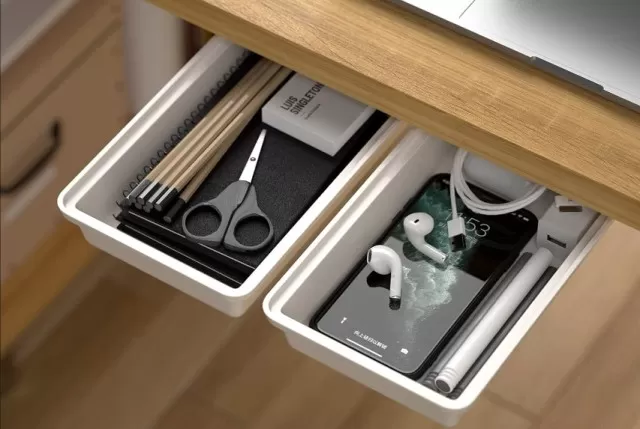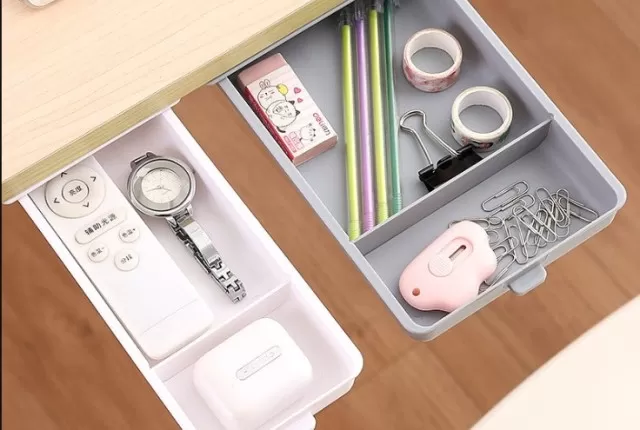By following the following desk drawer organization tips, you can maintain a tidy and efficient workspace that enhances your productivity.
Sure, having a neat and organized desk not only looks aesthetically pleasing but also contributes to a productive work environment.
However, it’s equally important to extend that organization to your desk drawers. A cluttered and disorganized drawer can make it difficult to find the office supplies you need, leading to frustration and wasted time during your workday.
Whether you’re setting up a Home Office or organizing your workspace at the office, implementing effective desk drawer organization strategies can make a significant difference.
A well-designed system ensures that you have easy access to your essential supplies and allows you to keep track of when it’s time to restock items like highlighters or binder clips.
Is it necessary to have drawers on my desk?

When working with limited space, finding room for a desk can already be a challenge, let alone fitting in a large desk with multiple drawers for storage.
However, the great news is that you don’t actually require a desk with an abundance of built-in drawers to effectively store all your belongings. Instead, you can make the most of the available space and maximize its potential for storage purposes.
Tips for Desk Drawers Organization

Streamline Your Office Supplies.
Before organizing your desk drawer, it’s essential to assess which items truly need to be stored there.
Consider removing things that are rarely used or could be stored elsewhere in the office. Take everything out of the drawer and divide them into two categories: items you need easy access to while working and items that can be stored elsewhere.
Use this opportunity to declutter and get rid of dried-out pens, broken rubber bands, and any other unnecessary items. This will help you create a pile of supplies that are ready to be organized back into your desk drawer.
Categorize Your Supplies.
Once you have identified the items you use regularly, go through them again and sort them by type.
You can choose to be specific or more general in your categorization. For example, group all your pencils together or create broader categories like writing utensils that include pens, highlighters, and markers.
Consider whether certain items should be kept on your desktop using a wire utensil caddy, while others can be stored in the drawer.
Use Organizers for Your Desk Drawer.
Now comes the fun part – finding organizers that suit both your desk drawer and your personal style.
Clear acrylic inserts are popular choices, but if they don’t appeal to you, there are other options available. Bamboo organizers, expandable trays, mesh containers, or even affordable alternatives like muffin trays or jewelry boxes can work as long as they fit the drawer and accommodate your items.
Longer, narrow organizers are ideal for rulers, while small square or circular ones are suitable for pushpins and paperclips.
Prevent Sliding with Putty.
To keep your organizers from sliding around inside the drawer, use a clever trick employed by professional organizers.
Roll up a small amount of putty or museum gel and place it on the corners of each organizer. This will keep them in place without damaging the bottom of the drawer.
If you need to reorganize, simply lift the inserts and refresh the putty or gel before placing them back down.

Consider DIY Dividers.
If you can’t find suitable containers for your desk drawer, consider using adjustable dividers instead.
These organizers offer more flexibility as you can space them out according to your needs. Long, narrow dividers work well for items like scissors and staplers, while some are designed to create custom compartments.
Look for bamboo spring-loaded dividers with or without separators for smaller items. Alternatively, you can get creative and make your DIY drawer dividers.
Organize Cords, Cables, and Chargers.
With the abundance of electronics in our digital age, it’s important to keep cords and chargers organized.
To save space in your desk drawer, ensure that all cables are neatly organized and compact. Use bundlers or wraps that allow you to label each cord for easy identification.
In a pinch, a small piece of Velcro can also be effective.
Label for Added Organization.
While not essential, labeling your desk drawer can enhance its organization in the long run.
Utilize a label maker to create labels for different categories or supply zones within the drawer. Attach the labels to the inside lip of the drawer or the visible part of the containers.
Label tape can be removed or rearranged as needed, allowing you to adjust your labels as your needs change.
Prioritize Your Top Drawer.
If your desk has multiple drawers, it’s important to utilize the additional storage space wisely.
Organize items you use daily in the top drawer, those you use once a week in the middle, and items you rarely use in the bottom drawer. If you only have one drawer, you can still prioritize by placing the most frequently used supplies front and center, while keeping less-used items towards the back.
*The information is for reference only.